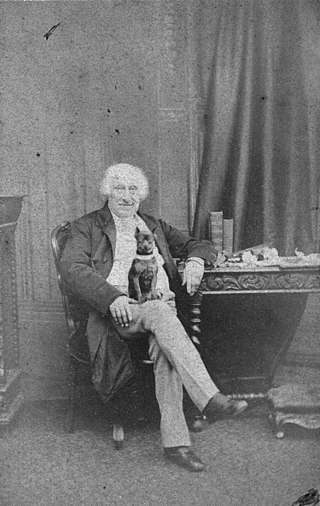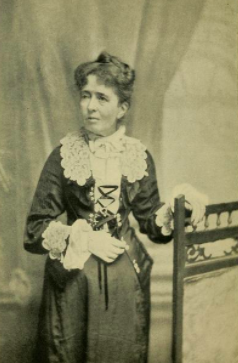Related Research Articles

Charles Piazzi Smyth was a British astronomer who was Astronomer Royal for Scotland from 1846 to 1888; he is known for many innovations in astronomy and, along with his wife Jessica Duncan Piazzi Smyth, his pyramidological and metrological studies of the Great Pyramid of Giza.

John Louis Emil Dreyer, also Johan Ludvig Emil Dreyer, was a Danish astronomer who spent most of his career working in Ireland. He spent the last decade of his life in Oxford, England.

Sir James South FRS FRSE PRAS FLS LLD was a British astronomer.

Ellen Mary Clerke was an Irish poet, linguist and a journalist. Originally from County Cork in Ireland, Clerke was educated in Italy. She wrote in English and Italian, publishing works on astronomy, travel, and poetry. Her journalistic works, including on European politics and current affairs, were published in several magazines in the 1880s and 1890s. Clerke died in London in 1906.

Agnes Mary Clerke was an Irish astronomer and writer, mainly in the field of astronomy. She was born in Skibbereen, County Cork, Ireland, and died in London.

Jesse Ramsden FRS FRSE was a British mathematician, astronomical and scientific instrument maker. His reputation was built on the engraving and design of dividing engines which allowed high accuracy measurements of angles and lengths in instruments. He produced instruments for astronomy that were especially well known for maritime use where they were needed for the measurement of latitudes and for his surveying instruments which were widely used for cartography and land survey both across the British Empire and outside. An achromatic eyepiece that he invented for telescopes and microscopes continues to be known as the Ramsden eyepiece.

The Dunsink Observatory is an astronomical observatory established in 1785 in the townland of Dunsink in the outskirts of the city of Dublin, Ireland.

Margaret Lindsay, Lady Huggins, born Margaret Lindsay Murray, was an Irish-English scientific investigator and astronomer. With her husband William Huggins she was a pioneer in the field of spectroscopy and co-wrote the Atlas of Representative Stellar Spectra (1899).

The Royal Observatory, Edinburgh (ROE) is an astronomical institution located on Blackford Hill in Edinburgh. The site is owned by the Science and Technology Facilities Council (STFC). The ROE comprises the UK Astronomy Technology Centre (UK ATC) of STFC, the Institute for Astronomy of the School of Physics and Astronomy of the University of Edinburgh, and the ROE Visitor Centre.

Hermann Alexander Brück CBE FRSE was a German-born astronomer, who spent the great portion of his career in various positions in Britain and Ireland.

The Edinburgh Astronomical Institution was founded in 1811 and wound up in 1847. It was instrumental in the foundation of the Royal Observatory, Edinburgh in 1822. The Institution raised funds, mostly by member subscription, to create three departments: A scientific observatory with an observer was to be under the control of the professors of mathematics, philosophy and astronomy of the University of Edinburgh, a popular observatory was to provide general instruction and amusement and a "physical cabinet" would comprise books, globes, meteorological and other instruments.
Mervyn Archdall Ellison was an Irish astronomer. He was recognized as a world authority on solar physics and the effect of solar flares on the Earth.
Mary Acworth Evershed was a British astronomer and scholar. Her work on Dante Alighieri was written under the pen name M.A. Orr.

Alice Everett was a British astronomer and engineer who grew up in Belfast. Everett is best known for being the first woman to be paid for astronomical work at the Royal Observatory, Greenwich, when she began her employment at the observatory January 1890. In 1903 she was the first woman to have a paper published by the Physical Society of London. She also contributed to the fields of optics and early television.
Isis Pogson,, was a British astronomer and meteorologist who was one of the first women to be elected as a fellow of the Royal Astronomical Society.
Jessica Duncan Piazzi Smyth made geological tours of the British Isles and Europe, and traveled to Egypt, Tenerife, and throughout the Mediterranean on scientific expeditions with her husband, Charles Piazzi Smyth, the Astronomer Royal for Scotland.

The Giuseppe S. Vaiana Astronomical Observatory is an astronomical observatory located in Palermo, Sicily, Italy, housed inside the Palazzo dei Normanni. It is one of the research facilities of the National Institute of Astrophysics. The observatory carries out research projects in the field of astronomy and astrophysics including the study of solar and stellar coronas, stellar evolution and of the supernova remnants.

Hugh Ernest Butler FRSE MRIA FRAS was a pioneering Welsh-born astronomer. Wartime work included important contributions to anti-aircraft gunnery followed in peacetime by major contributions to galactic and extragalactic research particularly via ballistic rockets. He promoted the idea of an orbiting space telescope as early as 1958.
The Regius Chair of Astronomy is one of eight Regius Professorships at the University of Edinburgh, and was founded in 1785. Regius Professorships are those that have in the past been established by the British Crown, and are still formally appointed by the current monarch, although they are advertised and recruited by the relevant university following the normal processes for appointing a professorship.
Patrick Wayman was an English astronomer and director of Dunsink Observatory from 1964 to 1992.
References
- ↑ "Penicuik". Trekearth.com. Retrieved 25 October 2021.
- 1 2 3 4 5 6 7 8 Davenhall, Clive (2009). "Dr. Mary Brück (1925–2008)". Journal of Astronomical History and Heritage . 12 (1): 81–83. Bibcode:2009JAHH...12...81D. doi:10.3724/SP.J.1440-2807.2009.01.08. S2CID 258224585.
- 1 2 3 4 5 6 7 8 Davenhall, Clive (2009). "Dr. Mary Brück (1925–2008)". Society for the History of Astronomy Bulletin . 18: 42–43. Bibcode:2009SHAN...18...42D.
- ↑ Stickland, David (2009). "Mary Teresa Brück (1925–2008)". The Observatory . 129: 180. Bibcode:2009Obs...129..180S.
- 1 2 3 Brand, Peter (2009), "Afterword", in Brück, Mary T. (ed.), Women in Early British and Irish Astronomy: Stars and Satellites, Dordrecht: Springer, pp. 265–266, Bibcode:2009webi.book.....B, doi:10.1007/978-90-481-2473-2, ISBN 978-90-481-2472-5
- ↑ "NASA/ADS". Ui.adsabs.harvard.edu. Retrieved 25 October 2021.
- ↑ Lorimer Medal of the Astronomical Society of Edinburgh, Astronomyedinburgh.org; accessed 2 October 2021.
- ↑ DCU names three buildings after inspiring women scientists, Raidió Teilifís Éireann, 5 July 2017.
- ↑ "Mary Brück Astronomer, astrophysicist and historian of science". University of Edinburgh.
- ↑ Brück, Hermann; Brück, Mary T. (1988). The Peripatetic Astronomer: The Life of Charles Piazzi Smyth. Bristol, England: A. Hilger. Bibcode:1988palc.book.....B.
- ↑ Brück, Mary T. (2002). Agnes Mary Clerke and the Rise of Astrophysics. Cambridge, England: Cambridge University Press. Bibcode:2002amcr.book.....B. ISBN 978-0521808446.
- ↑ Brück, Mary T. (2009). Women in Early British and Irish Astronomy: Stars and Satellites. Dordrecht: Springer. Bibcode:2009webi.book.....B. doi:10.1007/978-90-481-2473-2. ISBN 978-90-481-2472-5.
- ↑ Search for Brück as an author in the Oxford Dictionary of National Biography at Oxforddnb.com/. Retrieved 26 January 2016.
- ↑ Hockey, Thomas; Trimble, Virginia; Williams, Thomas R.; Bracher, Katherine; Jarrell, Richard A.; Marché, Jordan D.; Palmeri, JoAnn; Green, Daniel W. E., eds. (25 October 2014). Biographical Encyclopedia of Astronomers. Springer New York. Bibcode:2014bea..book.....H. doi:10.1007/978-1-4419-9917-7. ISBN 978-1-4419-9916-0. S2CID 242158697 . Retrieved 25 October 2021.